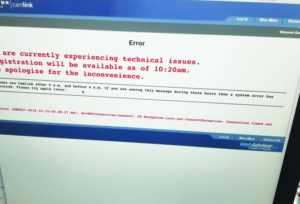Camlink, Camosun’s online course-registration system, went down on October 11 and again from October 13 to 15, leaving students and faculty unable to access the site. The crash came during registration for January 2019 courses.
Camosun registrar Scott Harris says that Colleague—the database platform Camosun uses—is “quite an old implementation” and that because it’s getting “very long in the tooth, the customizations are starting to cause issues.”
“It’s been customized over the years to ensure that it had the functionality that we and that students required,” says Harris.
The college is now partway through its Colleague renewal exercise, which Harris calls a “significant undertaking” that involves removing the customizations that are causing the bugs.
“Those customizations can be very invasive on the systems,” says Harris. “They can start to create issues over time, and that’s exactly what we experienced [the week of October 8].”

The customizations around Camosun-specific features such as web declare “imploded,” says Harris. As part of a multiple-year revamp plan, the college is making many adjustments to Camlink, including everything from changing how the technical department receives notifications when something goes wrong to replacing the web declare section. Harris says he has not ironed out the financial side of specific replacement plans because this is a multiple-year endeavour that the college is about halfway through. Harris adds that the college is always looking to be fair to students.
“We never want to be in a situation like this where students have a start time and aren’t able to get in,” says Harris. “It’s incredibly frustrating and very stressful.”
After the initial crash, Camlink was down from October 13 to 15 due to problems in the monitoring tools that Camosun’s technical team uses to keep an eye on the well-being of the computer systems across the college.
Second year Criminal Justice student Halie Gislason says that she had to contact the college due to the outage to be sure that she could still get into the courses she needed.
“I was trying to register for classes and the times kept changing,” she says. “I actually had to go talk to the chair of the program to make sure that I could get into the programs that I originally thought, because everything filled up.”
Gislason says Camlink on the whole is a “silly concept.”
“Why couldn’t we do it through D2L or something that we use daily, rather than a third or fourth party? It’s kind of inconvenient to students,” she says.
First-year Criminal Justice student Ryan Basi says he was also impacted by Camlink crashing.
“It was hard to register for classes. Now that they say the website’s up, I know everyone’s just waiting to register,” he says. “I feel like I’m going to be on the waiting list, or I won’t be able to get a lot of my classes that I wanted to get.”
Basi says his overall experience with Camlink has been okay, but it can be confusing at times.
“I mean, it’s been helpful, too,” he says. “I just hope they can make sure that the website doesn’t crash like it has been; it kind of sucks for the students to have to deal with it.”
Harris says that as part of the Camlink improvement plan, the college will be removing web declare and getting rid of the college’s customized registration process.
“Some of the things we’re looking at toward the future will be things like two-term registration, so when you register in the summer, you’re going to be registering for fall and winter at the same time,” he says. “Ultimately what we’re looking to do is get rid of the stuff that we have created over time that has added increased complexity to the system, and has also made things more confusing for students.”
Harris says the college is looking to use the systems in the way that they were designed to be used.
“The way that we’re doing the registration windows right now are based on program, and we’re looking at other practices that we think might be more fair and reasonable and clear for students,” says Harris.
Harris says only about a handful of students were not able to get into the courses they needed because of the crash; there were not more students than usual who were unable to get into the courses they needed because of this, he says.
“We’re dealing with that on a case-by-case basis,” says Harris. “We need to do a better job of making sure that students are communicated with.”
Shortly after Camlink crashed on October 11, an email was sent to impacted students at 2:13 pm informing them that their new registration time was that day at 2:30 pm. Harris says that the college is looking at options such as texting to improve its communication with students.
“If we have catastrophic things like this happen and we need to be able to communicate with students quickly,” says Harris, “email when they’re in class may not be the best way to do that.”
Harris says that some students wanted to move the registration cycle to the next day, but that would make things more unfair, he says.
“That would have meant all students in the registration cycle were impacted, and we’re trying to make sure that the impact was on as few students as possible.”
